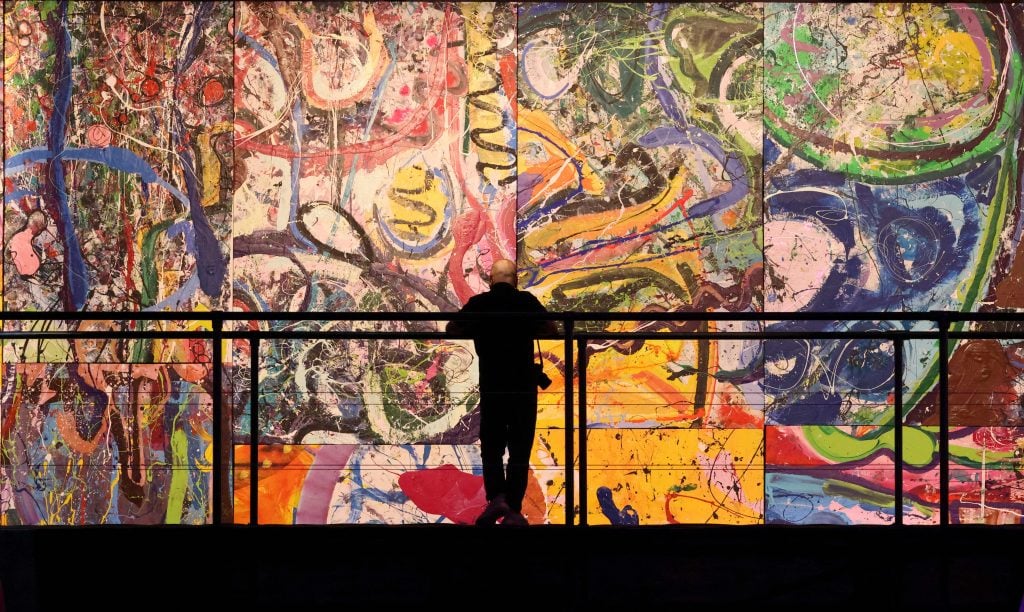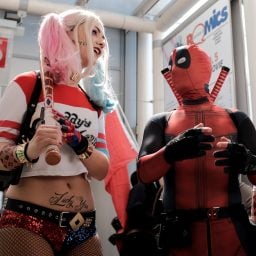Every Monday morning, Artnet News brings you The Gray Market. The column decodes important stories from the previous week—and offers unparalleled insight into the inner workings of the art industry in the process.
This week, drawing unsettling parallels to art-market history…
DOUBLE TROUBLE?
In a benefit auction last Monday night, avowed crypto-entrepreneur Andre Abdoune submitted a winning bid of $62 million for artist Sacha Jafri’s 17,000 square-foot canvas The Journey of Humanity. The towering price became the fourth-highest paid at auction for a work by a living artist, just two weeks after another blockchain baron launched Beeple into third place on the same list by paying $69.3 million for his digital-collage-and-NFT combo Everydays: The First 5,000 Days.
But while these fast-arriving results have rewritten the auction sector’s record books, they also bear eerie similarities to the bombastic buying that immediately preceded the art-market crash of the early 1990s. Teasing out the parallels between the two eras adds valuable specificity to the debate about whether speculative buying is once again nearing an unsustainable level.
Jafri’s behemoth painting set the Guinness World Record for “Largest Art Canvas” when he completed it in September 2020. He created the piece—a free-form composition of richly colored gestural abstractions inspired by drawings from children around the world—without assistants over eight grueling months spent holed up in the ballroom of Dubai’s otherwise-shuttered Palm Atlantis hotel. After opening an exhibition of 40 of the work’s 70 sections at Leila Heller Gallery’s Dubai space this February, Jafri offered it in a sale benefiting a consortium of nonprofits (including Dubai Cares, the Global Gift Foundation, UNESCO, and Unicef), with the hope of raising at least $30 million.
His aspiration seemed far too ambitious to many observers at the time, including me. My colleague Sarah Cascone noted that Jafri’s previous auction peak was just TWD $2.16 million (USD $70,745), paid for a modestly sized painting called The Dance of the Samurai in a 2019 auction at Ravenel in Taiwan. A $30 million price tag for The Journey of Humanity would have meant an increase of nearly 42,500 percent over his personal record under the hammer—an even more breathtaking leap given that the benefit sale only represented Jafri’s seventh appearance at auction… and, if successful, only the fourth time the work in question would have actually found a buyer, per the Artnet Price Database.
In the end, Abdoune more than doubled up on Jafri’s price aspirations. At $62 million, the “World’s Largest Art Canvas” jumped over the artist’s prior auction apex by 87,639 percent. That number is large enough to dissolve into meaningless abstraction without some kind of real-world anchor, so think about it this way: it’s about the same price difference that separates a Tesla Model S sedan (about $81,190) from a top-of-the line Gulfstream G650 private jet (about $66.5 million).
Yet the story of Beeple (AKA Mike Winkelmann) is even more extreme. When Christie’s put Everydays: The First 5,000 Days, a digital collage comprising roughly 13.5 years of the artist’s ongoing series of once-daily pieces, and its NFT on the block, it was the first Beeple work offered at auction by a traditional house. Two weeks later, Vignesh Sundaresan, aka Metakovan, purchased the package for $69.3 million, instantly transforming Beeple from an auction unknown into the third most expensive living artist in the public art market.
The Jafri and Beeple records would have raised my eyebrows even if they had simply been set within the same year. That they happened within 12 days of one another practically turned me into a cartoon character, especially since both buyers’ wealth purportedly came from the same source.
But it wasn’t because these propulsive results were unprecedented. On the contrary, it was because, to some degree, we’ve been here before… and it didn’t end well.
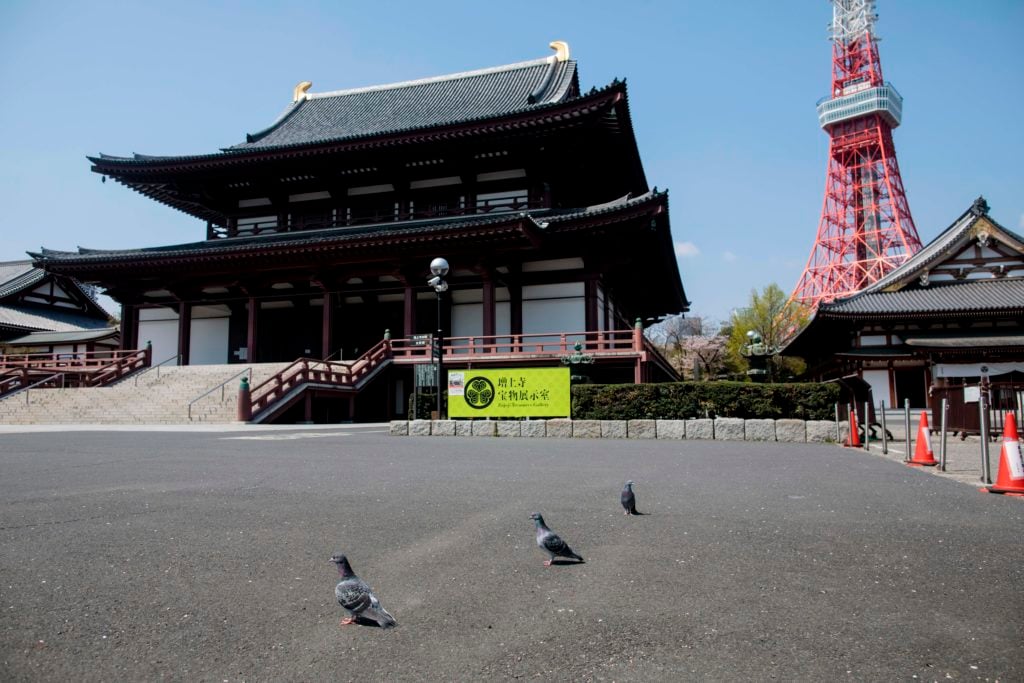
Pigeons wander at the grounds of the empty Zozoji Buddhist temple near the landmark Tokyo Tower in April 2020. (Photo by BEHROUZ MEHRI/AFP via Getty Images)
BIG IN JAPAN
On May 15, 1990, a Japanese paper magnate named Ryoei Saito stunned the art market by acquiring Vincent van Gogh’s Portrait of Dr. Gachet (1890) at Christie’s New York for $82.5 million with fees. At the time, it was the loftiest price ever paid for an artwork at auction.
But Saito wasn’t done with his paddle that week. Two days later, he waltzed into Sotheby’s New York to snatch Pierre-Auguste Renoir’s Au Moulin de la Galette (1876) for a premium-inclusive $78.1 million, making it then the second most expensive artwork in the history of the hammer.
Although these still sound like rich acquisitions even by 2021 standards, adjusting for inflation reveals them to be even gaudier. In today’s dollars, Saito would have paid $168 million for his van Gogh and $159 million for his Renoir—meaning he spent the contemporary equivalent of $327 million on two Impressionist paintings in 48 hours. That, dear reader, is what we call a flex.
Yet Saito wasn’t all that much of an outlier among the blue-chip collectors of the era. Impressionist and Modern paintings were regularly selling for hallucinatory prices at auction from the late 1980s into the early 1990s, almost entirely thanks to Japanese plutocrats whose wealth was rapidly inflated by what has now become one of the most infamous economic bubbles in modern financial history.
What happened? It’s complicated, but the main culprit was a mutant growth in the value of Japanese real estate. With the yen strong against the US dollar, and tech products enjoying high margins and healthy demand abroad, Japanese corporations began posting record profits in the mid-‘80s. Japan’s central bank tried to reassert some influence over its domestic economy by incentivizing colossal borrowing from homegrown lenders at low interest rates.
With coaxing from the government, much of the borrowed cash went into the Land of the Rising Sun’s real estate. As property values shot skyward, corporate and private land owners began taking out even more juicy loans against them; banks then turned around and packaged these mortgages into bonds to sell to investors. This blizzard of leveraged cash surged into the Japanese stock market and a rapidly expanding array of foreign acquisitions, perhaps best symbolized when, in 1989, Mitsubishi bought a controlling interest in Rockefeller Center for $846 million.
By 1990, financiers, politicians, and academics were all openly debating how soon Japan would unseat the US as the world’s largest economy. The tiny island nation then comprised 42 percent of global equity markets—up from 15 percent in 1980, according to wealth manager and market analyst Ben Carlson. On paper, Japanese real estate was worth quadruple all US real estate combined, and Tokyo’s Imperial Palace carried a higher valuation by itself than every square kilometer of property in Canada. Spurred by the disorienting rise in national wealth, membership to Japanese golf clubs became so pricey that the Nikkei invented a special index to track their value… which eventually summited at $200 billion.

Pierre-Auguste Renoir, Au moulin de la Galette (1876). Photo courtesy of the Musée d’Orsay, Paris.
No surprise, then, that Japan ruled the art market in this period. In February 1990, the Los Angeles Times reported that “Japanese dealers and collectors are snapping up about 40 to 50 percent of total sales at London-based Christie’s and Sotheby’s auction houses, in some cases, dealers say, with little regard for quality and price.”
Also relayed in the same piece: the Japanese foreign ministry confirmed that, between January and September 1989, the country imported $1.55 billion worth of just paintings, or about $3.25 billion in today’s dollars. For reference, that’s equivalent to about one-third of all fine-art sales made at auction in 2020, according to the latest Artnet Intelligence Report. Major corporate collections, such as the real-estate developer Maruko, were even doing a brisk side business selling fractional ownership in their Imp-Mod holdings, with prices climbing as high as $180,000 per share.
The good times did not last much longer. Between late 1989 and August 1992, the value of the Japanese stock-market shrunk by 60 percent. The country’s real-estate market fell deeper and deeper into a sinkhole over the “lost decade” of the 1990s; in fact, Carlson noted last month that Japanese home prices were still at only about half their late-‘80s apex.
Not surprisingly, the art market sunk right along with its most active buyers. According to the LA Times, prices for Impressionist works had already been cut in half by January 1993, and “a rash of bankruptcies by dealers and galleries [had] forced banks to take paintings in lieu of loan repayments.” Coupled with the long-smoldering aftermath of the 1987 Wall Street crash, the resulting fire sales of Impressionist and Modern works stoked an art-market inferno that lasted until the early 2000s.
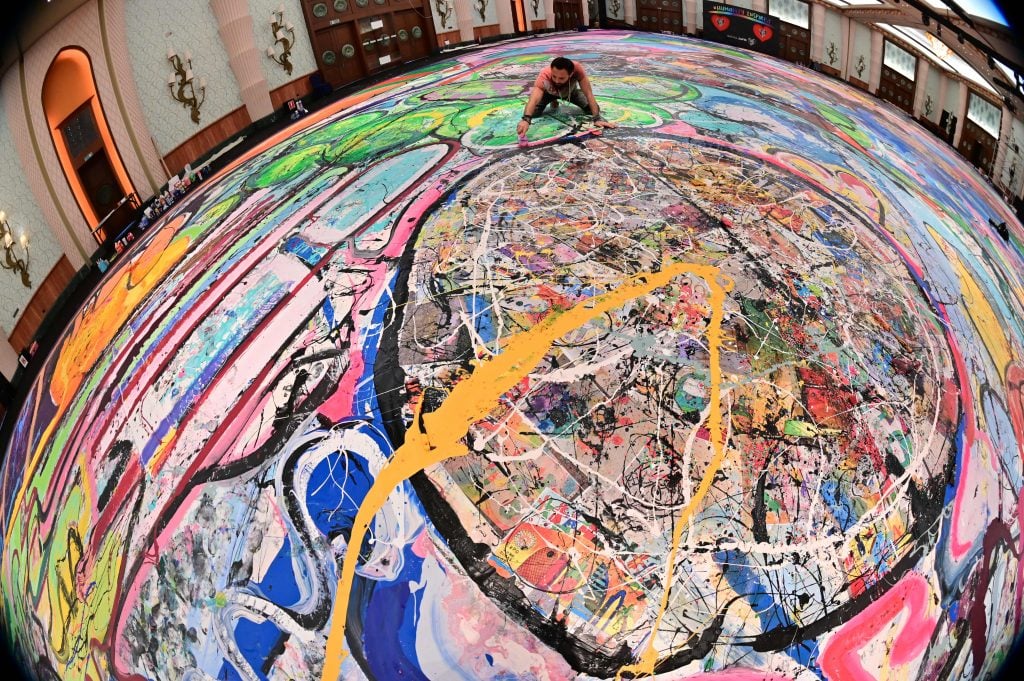
Sacha Jafri working on his record-breaking painting The Journey of Humanity on September 23, 2020, in the Emirati city of Dubai. Photo by Giuseppe Cacace/AFP via Getty Images.
TIME IS A FLAT CIRCLE
What has been happening recently among the crypto-wealthy does not flawlessly mirror what happened among Japan’s art speculators just before the late ’80s bubble imploded. But I think we’re now seeing enough similar contours to make the comparison worthy of serious reflection.
Like Japanese asset prices more than three decades ago, crypto-assets are now on an unsustainable run. Just consider the price trajectory of bitcoin and ether, the two most important cryptocurrencies, over the past five years. On March 26, 2016, one bitcoin traded at $417; as of my writing, it trades at $55,880—a rise of more than 13,300 percent. Five years ago, one ether was worth $10.72; today it’s worth $1,705—an increase of 15,900 percent.
Since we’re verging on statistical abstraction again, let’s look at it this way: The average hedge fund returned 11.6 percent in 2020, according to data reviewed by Reuters. Over that same period, bitcoin and ether rose in value by 378 percent and 539 percent, respectively. So if you held one of those two cryptocurrencies throughout last year, your blockchain-based investment made you either 32.5 times or 46.5 times richer than if you’d invested the same amount with a typical hedge fund.
Little wonder, then, that the buyers bidding up this month’s most talked-about fine-art lots were crypto-whales: right now, it’s almost impossible to outspend them if they want to go all-in.
And man, are they ever going in. Here’s a telling moment from Jafri’s interview with Anna Brady of The Art Newspaper:
At Monday night’s auction, telephone bids came in from “Miami, LA, Mexico, South America, London, a lot in Switzerland—I guess that’s all the boys who have made a lot of money in crypto—China and Hong Kong,” Jafri says. “Then Andre bid at $50m and he got it at $62m.”
In Christie’s Beeple sale, all indications are that Sundaresan (or Metakovan, if you want to keep it in The Matrix) was also mainly fighting off his fellow crypto-crats. The underbidder on Everydays was Justin Sun, an entrepreneur behind multiple blockchain ventures. Christie’s also noted after the sale that 91 percent of participating bidders were new to the house. While it’s impossible to know how many of these blue-chip auction neophytes were bitcoin or ether millionaires, my conversations among the crypto-knowledgeable lead me to bet that the number is high.
If you don’t yet see the ghost of the Japanese asset-price bubble in crypto-collectors’ unbeatable buying power and rapid rewriting of the auction-price record books, here’s one more ominous echo: some of the trophy lots are once again being spun out into fractionalized-ownership ventures.
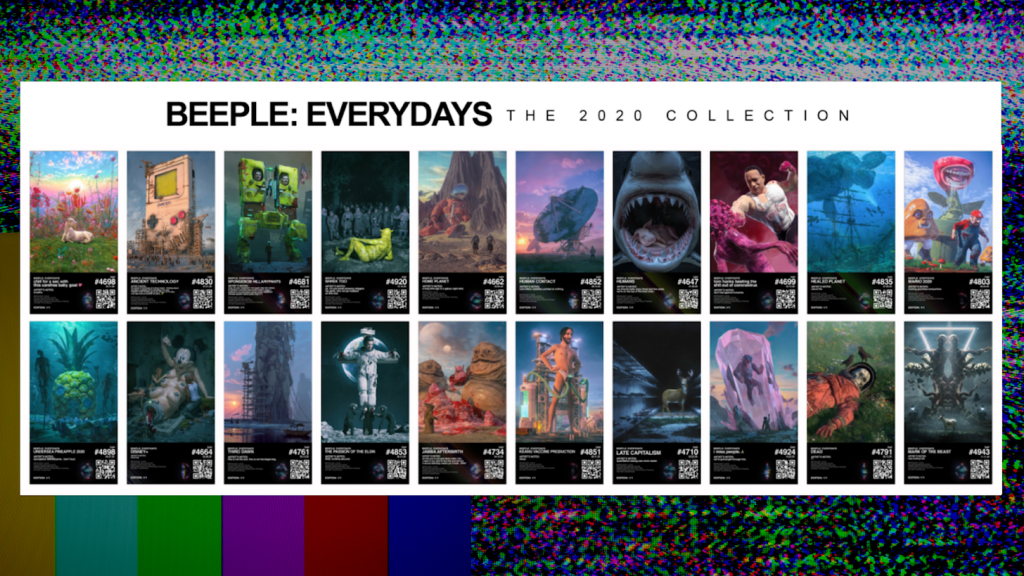
Beeple’s “Beeple Everydays: The 2020 Collection.” Courtesy of Metapurse.
Metapurse, the combination NFT collection and seed fund for other blockchain projects owned by Sundaresan/Metakovan, also happens to be selling its own cryptocurrency called the B.20 token. Metapurse’s utopian pitch for B.20 centers on the notion that “everyone can have ownership over the first large scale public art project within the metaverse” including Everydays: The First 5,000 Days and 20 other Beeple works previously acquired for $2.2 million.
In contrast, my colleague Ben Davis neatly summarized B.20 as “an investment scheme that allows you to bet real money on Metapurse’s bundle of digital assets, with the hope that it will appreciate in value over the long haul.”
However you want to look at Metapurse’s token, though, there’s no denying that it calls back to Maruko, the Japanese real-estate developer hocking fractionalized shares of Chagalls and Renoirs to an eager public swimming in speculative wealth. The artists are different, and so is the source of so much of the cash sloshing around them. But the market dynamics are hauntingly similar.
The same is true when we zoom back out to the larger picture of record-smashing sales in the auction sector, with a handful of buyers fighting among themselves for the chance to spend bombastic sums on artworks tapped into the zeitgeist. As ever, correlation is not necessarily causation. But it’s not necessarily coincidence, either.
Even if we will someday look back at the mind-melting prices paid for Jafri and Beeple’s works this month as proof a new house of cards was nearing the point of collapse, it could take months, even years, before it all goes down. The Japanese asset-price bubble proved as much. Still, if you’re an art-market player chasing crypto-wealth toward the pinnacle, keep in mind that it’s always better to have an exit plan well before you need it.
[Artnet News]
That’s all for this week. ‘Til next time, remember: if you look around the space and can’t tell who the sucker is, then there’s a good chance the sucker is you.
Follow Artnet News on Facebook:
Want to stay ahead of the art world? Subscribe to our newsletter to get the breaking news, eye-opening interviews, and incisive critical takes that drive the conversation forward.
